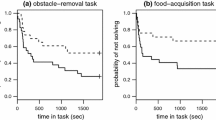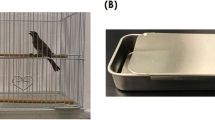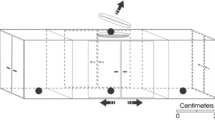Abstract
Behavioural flexibility is an important component of adaptation because it can help animals to exploit new or diverse habitats. Due to abundance of novel objects and resources provided by humans, urban environments may select for behavioural flexibility, but empirical evidence for this hypothesis is controversial. In this study, we compared urban and rural house sparrows (Passer domesticus) in four foraging problem-solving tasks. In the most difficult task, urban birds with large body mass were faster than others. Urban and rural birds performed similarly in the three easier tasks and did not differ in their learning efficiency. Individuals successful in one task tended to be successful in other tasks, and the repeatability of performance did not differ between urban and rural birds. Individuals that attempted to access food more frequently solved the problem faster in all tasks, but urban and rural birds did not differ in the frequency of attempts. These results suggest that the effects of urbanization on problem-solving success are weak and context-dependent in house sparrows. We propose that while urban animals may be better at exploiting some aspects of novel environments than rural conspecifics, such differences may be modulated by other habitat effects such as reduced nestling development and adult body mass in urban sparrows, which might influence some long-term determinants of innovativeness such as cognitive capacity or physical skills.


Similar content being viewed by others
References
Amiel JJ, Tingley R, Shine R (2011) Smart moves: effects of relative brain size on establishment success of invasive amphibians and reptiles. PLoS One 6:e18277
Anderson TR (2006) Biology of the ubiquitous house sparrow: from genes to population. Oxford University Press, New York
Arnold KE, Ramsay SL, Donaldson C, Adam A (2007) Parental prey selection affects risk-taking behaviour and spatial learning in avian offspring. Proc Biol Sci 274:2563–2569
Bell AM, Hankison SJ, Laskowski KL (2009) The repeatability of behaviour: a meta-analysis. Anim Behav 77:771–783
Bellisle F (2007) Effects of diet on behaviour and cognition in children. Br J Nutr 92:S227
Benson-Amram S, Holekamp KE (2012) Innovative problem solving by wild spotted hyenas. Proc R Soc Lond B 279:4087–4095
Bókony V, Kulcsár A, Liker A (2010) Does urbanization select for weak competitors in house sparrows? Oikos 119:437–444
Bókony V, Kulcsár A, Tóth Z, Liker A (2012a) Personality traits and behavioral syndromes in differently urbanized populations of house sparrows (Passer domesticus). PLoS One 7:e36639
Bókony V, Seress G, Nagy S, Lendvai ÁZ, Liker A (2012b) Multiple indices of body condition reveal no negative effect of urbanization in adult house sparrows. Landsc Urban Plan 104:75–84
Bókony V, Lendvai ÁZ, Vágasi CI et al (2014) Necessity or capacity? Physiological state predicts problem-solving performance in house sparrows. Behav Ecol 25:124–135
Boogert NJ, Reader SM, Hoppitt W, Laland KN (2008) The origin and spread of innovations in starlings. Anim Behav 75:1509–1518
Boogert NJ, Monceau K, Lefebvre L (2010) A field test of behavioural flexibility in Zenaida doves (Zenaida aurita). Behav Process 85:135–141
Bouchard J, Goodyer W, Lefebvre L (2007) Social learning and innovation are positively correlated in pigeons (Columba livia). Anim Cogn 10:259–266
Brosnan SF, Hopper LM (2014) Psychological limits on animal innovation. Anim Behav 92:325–332
Carrete M, Tella JL (2011) Inter-individual variability in fear of humans and relative brain size of the species are related to contemporary urban invasion in birds. PLoS One 6:e18859
Cole EF, Cram DL, Quinn JL (2011) Individual variation in spontaneous problem-solving performance among wild great tits. Anim Behav 81:491–498
Cooper RM, Zubek JP (1958) Effects of enriched and restricted early environments on the learning ability of bright and dull rats. Can J Psychology 12:159–164
Coppens CM, de Boer SF, Koolhaas JM (2010) Coping styles and behavioural flexibility: towards underlying mechanisms. Philos T Roy Soc B 365:4021–4028
Echeverría AI, Vassallo AI (2008) Novelty responses in a bird assemblage inhabiting an urban area. Ethology 114:616–624
Evans KL, Chamberlain DE, Hatchwell BJ, Gregory RD, Gaston KJ (2011) What makes an urban bird. Glob Change Biol 17:32–44
Gonzalez G, Sorci G, Smith LC (2001) Testosterone and sexual signalling in male house sparrows (Passer domesticus). Behav Ecol Sociobiol 50:557–562
Greenberg R (2003) The role of neophobia and neophilia in the development of innovative behaviour of birds. In: Reader SM, Laland KN (eds) Animal innovation. Oxford University Press, Oxford, pp 175–196
Griffin AS, Guez D (2014) Innovation and problem solving: A review of common mechanisms. Behav Process (published online, doi: 10.1016/j.beproc.2014.08.027)
Griffin AS, Guez D, Lermite F, Patience M (2013a) Tracking changing environments: innovators are fast, but not flexible learners. PLoS One 8:e84907
Griffin AS, Lermite F, Perea M, Guez D (2013b) To innovate or not: Contrasting effects of social groupings on safe and risky foraging in Indian mynas. Anim Behav 86:1291–1300
Griffin AS, Diquelou M, Perea M (2014) Innovative problem solving in birds: a key role of motor diversity. Anim Behav 92:221–227
Heij CJ, Moeliker CW (1990) Population dynamics of Dutch House sparrows in urban, suburban and rural habitats. In: Pinowski J, Summers-Smith JD (eds) Granivorous birds in the agricultural landscape. PWN, Polish Scientific Publishers, Warsaw
Hole DG, Whittingham MJ, Bradbury RB, Anderson GQA, Lee PLM, Wilson JD, Krebs JR (2002) Widespread local house-sparrow extinctions. Nature 418:931–932
Jensen H, Bremset EM, Ringsby TH, Saether BE (2007) Multilocus heterozygosity and inbreeding depression in an insular house sparrow metapopulation. Mol Ecol 16:4066–4078
Julious SA (2004) Sample sizes for clinical trials with normal data. Stat Med 23:1921–1986
Kark S, Iwaniuk A, Schalimtzek A, Banker E (2007) Living in the city: can anyone become an “urban exploiter”? J Biogeogr 34:638–651
Katsnelson E, Motro U, Feldman MW, Lotem A (2011) Individual-learning ability predicts social-foraging strategy in house sparrows. Proc Biol Sci 278:582–589
Keagy J, Savard J-F, Borgia G (2009) Male satin bowerbird problem-solving ability predicts mating success. Anim Behav 78:809–817
Keagy J, Savard J-F, Borgia G (2011) Complex relationship between multiple measures of cognitive ability and male mating success in satin bowerbirds, Ptilonorhynchus violaceus. Anim Behav 81:1063–1070
Kekkonen J, Seppä P, Hanski IK, Jensen H, Väisänen RA, Brommer JE (2011) Low genetic differentiation in a sedentary bird: house sparrow population genetics in a contiguous landscape. Heredity 106:183–190
Lefebvre L (1995) The opening of milk bottles by birds: Evidence for accelerating learning rates, but against the wave-of-advance model of cultural transmission. Behav Process 34:43–53
Lefebvre L, Whittle P, Lascaris E (1997) Feeding innovations and forebrain size in birds. Anim Behav 53:549–560
Lessells CM, Boag PT (1987) Unrepeatable repeatabilities: a common mistake. Auk 104: 116–121
Liker A, Bókony V (2009) Larger groups are more successful in innovative problem solving in house sparrows. Proc Natl Acad Sci U S A 106:7893–7898
Liker A, Papp Z, Bókony V, Lendvai ÁZ (2008) Lean birds in the city: body size and condition of house sparrows along the urbanization gradient. J Anim Ecol 77:789–795
Liker A, Bókony V, Kulcsár A, Tóth Z, Szabó K, Kaholek B, Pénzes Z (2009) Genetic relatedness in wintering groups of house sparrows (Passer domesticus). Mol Ecol 18:4696–4706
Lucas A, Morley R, Cole TJ (1998) Randomised trial of early diet in preterm babies and later intelligence quotient. Br Med J 317:1481–1487
Maklakov AA, Immler S, Gonzalez-Voyer A, Ronn J, Kolm N (2011) Brains and the city: big-brained passerine birds succeed in urban environments. Biol Lett 7:730–732
Martin L, Fitzgerald L (2005) A taste for novelty in invading house sparrows, Passer domesticus. Behav Ecol 16:702–707
Matzel LD, Wass C, Kolata S (2011) Individual differences in animal intelligence: learning, reasoning, selective attention and inter-species conservation of a cognitive trait. Int J Comp Psychol 24:36–59
Miranda AC, Schielzeth H, Sonntag T, Partecke J (2013) Urbanisation and its effects on personality traits: a result of microevolution or phenotypic plasticity? Glob Chang Biol 19:2634–2644
Møller AP (2009) Successful city dwellers: a comparative study of the ecological characteristics of urban birds in the Western Palearctic. Oecologia 159:849–858
Morand-Ferron J, Cole EF, Rawles JEC, Quinn JL (2011) Who are the innovators? a field experiment with 2 passerine species. Behav Ecol 22:1241–1248
Overington SE, Morand-Ferron J, Boogert NJ, Lefebvre L (2009) Technical innovations drive the relationship between innovativeness and residual brain size in birds. Anim Behav 78:1001–1010
Overington SE, Cauchard L, Côté K-A, Lefebvre L (2011) Innovative foraging behaviour in birds: what characterizes an innovator? Behav Process 87:274–285
Pap PL, Vágási CI, Czirják GÁ, Barta Z (2008) Diet quality affects postnuptial molting and feather quality of the house sparrow (Passer domesticus): interaction with humoral immune function? Can J Zool 86:834–842
Pap PL, Vágási CI, Czirják GÁ, Titilincu A, Pintea A, Osváth G, Fülöp A, Bartha Z (2011) The effect of coccidians on the condition and immune profile of molting house sparrows (Passer domesticus). Auk 128:330–339
Peach WJ, Vincent KE, Fowler JA, Grice PV (2008) Reproductive success of house sparrows along an urban gradient. Anim Conserv 11:493–503
Poston JP, Hasselquist D, Stewart IRK, Westneat DF (2005) Dietary amino acids influence plumage traits and immune responses of male house sparrows, Passer domesticus, but not as expected. Anim Behav 70:1171–1181
R Core Team (2012) R: a language and environment for statistical computing. Vienna (Austria): R foundation for statistical computing. Available from: http://www.r-project.org/
Ramsey G, Bastian ML, van Schaik C (2007) Animal innovation defined and operationalized. Behav Brain Sci 30:393–407
Reader SM, Laland KN (2002) Social intelligence, innovation, and enhanced brain size in primates. Proc Natl Acad Sci U S A 99:4436–4441
Reader SM, Laland KN (2003) Animal innovation. Oxford University Press, Oxford
Rowe C, Healy SD (2014) Measuring variation in cognition. Behav Ecol (published online,doi: 10.1093/beheco/aru090)
Sætre GP, Riyahi S, Aliabadian M, Hermansen JS, Hogner S, Olsson U, Gonzales Rojas MF, Sætre SA, Trier CN, Elgvin TO (2012) Single origin of human commensalism in the house sparrow. J Evol Biol 25:788–796
Seress G, Bókony V, Pipoly I, Szép T, Nagy K, Liker A (2012) Urbanization, nestling growth and reproductive success in a moderately declining house sparrow population. J Avian Biol 43:403–414
Sih A (2013) Understanding variation in behavioural responses to human-induced rapid environmental change: a conceptual overview. Anim Behav 85:1077–1088
Snell-Rood EC, Wick N (2013) Anthropogenic environments exert variable selection on cranial capacity in mammals Anthropogenic environments exert variable selection on cranial capacity in mammals. Proc R Soc B 280:20131384
Sol D, Lefebvre L (2000) Behavioural flexibility predicts invasion success in birds introduced to New Zealand. Oikos 90:599–605
Sol D, Timmermans S, Lefebvre L (2002) Behavioural flexibility and invasion success in birds. Anim Behav 63:495–502
Sol D, Duncan RP, Blackburn TM, Cassey P, Lefebvre L (2005) Big brains, enhanced cognition, and response of birds to novel environments. Proc Natl Acad Sci U S A 102:5460–5465
Sol D, Bacher S, Reader SM, Lefebvre L (2008) Brain size predicts the success of mammal species introduced into novel environments. Am Nat 172:63–71
Sol D, Griffin AS, Bartomeus I, Boyce H (2011) Exploring or avoiding novel food resources? The novelty conflict in an invasive bird. PLoS One 6:e19535
Sol D, Griffin AS, Bartomeus I (2012a) Consumer and motor innovation in the common myna: the role of motivation and emotional responses. Anim Behav 83:179–188
Sol D, Maspons J, Vall-Llosera M, Bartomeus I, García-Peña GE, Piñol J, Freckleton RP (2012b) Unraveling the life history of successful invaders. Science 337:580–583
Sol D, Lapiedra O, González-Lagos C (2013) Behavioural adjustments for a life in the city. Anim Behav 85:1101–1112
Suárez-Rodríguez M, López-Rull I, Garcia CM (2013) Incorporation of cigarette butts into nests reduces nest ectoparasite load in urban birds: new ingredients for an old recipe? Biol Lett 9:15–18
Thornton A, Lukas D (2012) Individual variation in cognitive performance: developmental and evolutionary perspectives. Philos T Roy Soc B 367:2773–2783
Thornton A, Samson J (2012) Innovative problem solving in wild meerkats. Anim Behav 83:1459–1468
Thornton A, Isden J, Madden JR (2014) Toward wild psychometrics: linking individual cognitive differences to fitness. Behav Ecol 25:1299–1301
Vangestel C, Mergeay J, Dawson DA, Vandomme V, Lens L (2011) Spatial heterogeneity in genetic relatedness among house sparrows along an urban–rural gradient as revealed by individual-based analysis. Mol Ecol 20:4643–4653
Vincze E, Papp S, Preiszner B, Seress G, Liker A, Bókony V (2014) Does urbanization facilitate individual recognition of humans by house sparrows? Anim Cogn (published online,doi: 10.1007/s10071-014-0799-z)
Wright TF, Eberhard JR, Hobson EA, Avery ML, Russello MA (2010) Behavioral flexibility and species invasions: the adaptive flexibility hypothesis. Ethol Ecol Evol 22:393–404
Acknowledgments
We thank Gábor Seress for help with capturing birds. The Zoo of Veszprém provided facilities for bird housing. The study was financed by the Hungarian Scientific Research Fund (OTKA, K84132). During the study, AL was supported by a Marie Curie Intra-European Fellowship. During the preparation of the manuscript, we were also supported by the European Union, with the co-funding of the European Social Fund (SP, BP, and EV by TÁMOP-4.2.2.A-11/1/KONV-2012-0064, and VB by TÁMOP-4.2.4.A/ 2-11/1-2012-0001 ‘National Excellence Program’).
Conflict of interest
The authors of this manuscript declare to have no conflict of interest.
Ethical standards
All procedures were in accordance with ASAB’s ethical guidelines and Hungarian laws, licensed by the Middle Transdanubian Inspectorate for Environmental Protection, Natural Protection and Water Management (permission number: 31559/2011).
Author information
Authors and Affiliations
Corresponding author
Additional information
Communicated by C. M. Garcia
Rights and permissions
About this article
Cite this article
Papp, S., Vincze, E., Preiszner, B. et al. A comparison of problem-solving success between urban and rural house sparrows. Behav Ecol Sociobiol 69, 471–480 (2015). https://doi.org/10.1007/s00265-014-1859-8
Received:
Revised:
Accepted:
Published:
Issue Date:
DOI: https://doi.org/10.1007/s00265-014-1859-8




